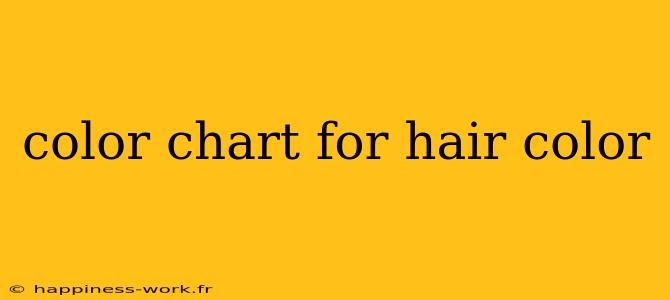Choosing the right hair color can be a transformative experience, not only enhancing your appearance but also boosting your confidence. With numerous options available, a hair color chart serves as a valuable tool in making an informed decision. In this article, we will explore hair color charts, delve into various hair color categories, and provide practical examples to help you find the perfect shade.
What is a Hair Color Chart?
A hair color chart is a visual guide that displays a range of hair colors and shades. It typically includes:
- Natural Colors: These consist of shades like blonde, brunette, black, and red, representing what you would find in nature.
- Fashion Colors: Bright, unconventional shades such as pastels, vivid reds, and deep blues fall into this category.
- Tones and Undertones: Each color has various tones (cool, warm, neutral) that can affect the final appearance once applied.
Why Use a Hair Color Chart?
Hair color charts serve several important purposes:
- Visual Reference: They allow you to see the range of colors available before committing to a dye job.
- Color Matching: Charts can help you match your current color or desired color to find the best option.
- Understanding Undertones: They educate you about the warm or cool undertones in each shade, assisting you in choosing a color that complements your skin tone.
Key Questions About Hair Color Charts
1. What Should I Consider When Choosing a Hair Color?
When selecting a hair color, consider the following factors:
- Skin Tone: Cool undertones usually pair well with ash blonde or cool brown shades, while warm undertones often look best with golden blondes or rich browns.
- Eye Color: Certain shades can enhance your eye color. For example, green eyes pop with shades of copper or warm browns.
- Maintenance: Darker colors can be easier to maintain than lighter shades, which may require frequent touch-ups.
2. What are the Different Types of Hair Color?
Hair color is generally categorized into four main types:
- Permanent Color: Provides long-lasting results but can be damaging to the hair.
- Semi-Permanent Color: Lasts a few weeks and is less damaging, allowing for more experimentation.
- Demi-Permanent Color: Offers a balance between permanent and semi-permanent, lasting longer than semi-permanent but without the harshness of permanent dye.
- Temporary Color: Great for those looking to try a new shade without commitment; typically washes out in a few shampoos.
Practical Examples of Using a Hair Color Chart
-
Finding Your Shade: If you have a medium skin tone, start by referring to a chart to explore medium brown and dark blonde options. Notice how different undertones affect the overall look. For instance, ash brown might suit you better than a golden brown.
-
Color Complementation: Let’s say you have hazel eyes. You could choose a warm chestnut or rich auburn, using the hair color chart to guide you toward shades that will accentuate your eye color.
-
Trendy Colors: If you want to experiment with fun colors, refer to charts featuring fashion colors. Decide whether you prefer a pastel lilac or a bold electric blue, and consider if these shades will match your personal style and lifestyle.
How to Use Hair Color Charts Effectively
- Check Under Different Lighting: Always view a hair color chart in natural light to see the true color.
- Bring Swatches: If visiting a salon, bring hair swatches from the chart that you are considering. This aids in discussion with your stylist.
- Test on a Small Section: Before full application, conduct a strand test to see how the color looks on your hair.
Conclusion
Understanding hair color charts can enhance your hair-dyeing experience and ensure that you select a shade that fits your personality, style, and lifestyle. With careful consideration of your skin tone, eye color, and maintenance routine, you can achieve a look you love. Remember to always consult a professional stylist if you're uncertain, as they can provide additional insight and recommendations tailored to your unique features.
By utilizing this guide and incorporating the insights from a hair color chart, you'll be well on your way to achieving your perfect hair color.
Further Resources
For more information on hair color trends, maintenance tips, and styling advice, be sure to explore trusted beauty blogs, videos, and salons.
Attribution: This article builds on content and concepts derived from WikiHow articles on hair color choices, color matching, and product types. For more detailed instructions and visual resources, visit WikiHow on Hair Colors.
